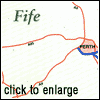|
The Central Region
The vast agricultural heart of the Kingdom dominates
the interior of Fife and most of its towns are connected with this activity. Cupar
is its main town and was once Fife's administrative centre with many civic functions
still based there. It is a pleasant stop for a stroll around the town but there is
not much to see. Ostler's Close bistro-restaurant is worth seeking out just off the
main street.
Around Cupar
 Two miles (3km) south of Cupar is an Edwardian country house,
beautifully remodelled by Robert Lorimer in 1906, the Hill of Tarvit. It was originally
built for one of Dundee's jute barons and among the fine collection of treasures
inside are sixteenth century tapestries, Chinese porcelain and eighteenth century
English and French furniture. Two miles (3km) south of Cupar is an Edwardian country house,
beautifully remodelled by Robert Lorimer in 1906, the Hill of Tarvit. It was originally
built for one of Dundee's jute barons and among the fine collection of treasures
inside are sixteenth century tapestries, Chinese porcelain and eighteenth century
English and French furniture.
The magnificent central hall is encased in panelled
oak and adorned with fine paintings of the Dutch school. The gardens are equally
impressive and there is a woodland walk leading to a hilltop viewpoint looking north
over the Howe of Fife. A mile further south, on the same road, is Scotstarvit Tower,
known to have been in existence since 1579. It now stands deserted.
Ceres lies 3 miles (5km) south of Cupar just below
Scotstarvit Tower. It has appealing pantile cottages surrounding a village green
and an ancient cobbled bridge crossing the shallow river. Some of the cottages and
the bridge have been there for more than 650 years. The men of Ceres supposedly marched
across the bridge on their way to the battle of Bannockburn and on their return celebrated
their victory with games on the village green. The games are still an annual event,
on the last Saturday in June, with the Ceres Derby the highlight of the day.
There is a monument beside the green, which recalls
the village's proud heritage. Across the Ceres Burn bridge, the Fife Folk Museum
is housed in part of the seventeenth century Tolbooth weigh-house and two adjoining
cottages. The award-winning museum displays crafts and trades, costumes, tools and
utensils that were commonplace throughout rural Fife over the past two centuries.
Set on the gates just beyond the museum is a genial little statue called The Provost,
said to represent the last ecclesiastical provost of the village.
 Three miles (5km) south-east of Ceres on the B940 is Peat
Inn where an eighteenth-century building houses a restaurant of the same name that
has a world-wide reputation. The French-influenced decor is matched by French/Scottish
cuisine that is considered by some the best in Scotland. Three miles (5km) south-east of Ceres on the B940 is Peat
Inn where an eighteenth-century building houses a restaurant of the same name that
has a world-wide reputation. The French-influenced decor is matched by French/Scottish
cuisine that is considered by some the best in Scotland.
Swinging north and west, Rankeilour Park, formerly
known as the Scottish Deer Centre, is set 3 miles (5km) west of Cupar on the A91.
There are still a variety of deer species to be seen during ranger-led tours, falconry
displays, a film presentation and scenic walkways. There are also indoor and outdoor
adventure parks for children as well as a restaurant, winery and several well-stocked
gift shops in the Courtyard Shopping area.
Dairsie, 3 miles (5km) east of Cupar just off the
A91, has a bridge over the River Eden that was built by Archbishop Beaton in 1522.
Dairsie Castle lies above the river. Dura Den is an enchanting wooded gorge south
of the bridge where a large number of fossils have been found, giving vital clues
to the formation of land and life here over millions of years. Beside the Ceres burn
you can see the ruins of several linen and jute mills which were once an important
part of the Fife economy.
Falkland
Ten miles (16km) south-west of Cupar and tucked away
at the foot of the Lomond Hills is the ancient and beautiful Royal Burgh of Falkland.
Here stands the great palace of the Stuarts, a favourite residence of many Scottish
kings and queens. The palace is in the heart of the town, which is a surprise in
itself, showing a remarkable lack of class distinction, rare in medieval Scotland.
It was built as a hunting lodge for royalty who came here to hunt deer and wild boar
in the surrounding forest.
Facing the street, the south front is a splendid example
of Scottish Gothic with its buttresses, niches and statues of Christ and the saints.
Scotland has few surviving buildings that were in the mainstream of Renaissance architecture,
but here is one, which ranks among the best. The building shows a strong French influence
but there is a flavour about it that is unmistakably Scottish. Most of the existing
palace was built in the early sixteenth century by James IV and his son James V.
The Royal Tennis court at Falkland was built in 1539, the second oldest in Britain
after Henry VIII's at Hampton Court, and is still in use.
The name of the larger village of Auchtermuchty is
often scoffed at for its parochial enunciation but it is also well known for its
musical associations. Scotland's premier accordion player cherished by many older
Scots around the world, Jimmy Shand, comes from here. The Auchtermuchty Folk Festival
attracts players from all over the country and regular impromptu sessions occur in
the lounge bars. The duo, the 'Proclaimers,' also hail from 'Muchty'. The High Street
is the most interesting architectural area with an elegant early eighteenth century
Tolbooth.
The road to the Firth of Tay
A minor road leads out of town to the north, the B936
signposted to Newburgh. Lying on the shore of the River Tay, Newburgh has a long
main street and an illustrious history. The aspect of the cobbled sidings and many
of the dwellings testify to some antiquity although the outlying areas are rather
dowdy. The Laing Museum is the main focus for visitors, established in 1896 by a
historian and banker, Dr Alexander Laing. It displays a fossil fish found in Dura
Den and material on the town's past and movement of the Scottish people through the
ages.
 To the east of town are the ruins of the twelfth century Lindores
Abbey. There is little of the buildings left apart from orange-stoned arches and
fragments of the once great walls which suffered spoliation in 1559 at the hands
of John Knox and his followers, as well as local pilfering for other building projects. To the east of town are the ruins of the twelfth century Lindores
Abbey. There is little of the buildings left apart from orange-stoned arches and
fragments of the once great walls which suffered spoliation in 1559 at the hands
of John Knox and his followers, as well as local pilfering for other building projects.
Heading east, the road bordering the wide River Tay
is narrow, scenic and winding. The city of Dundee comes into view at several points
but 3 miles (5km) west of the Tay Rail Bridge is Balmerino, known for its abbey,
which stands on a hill overlooking the river. Alexander II whose mother, Ermengarde,
widow of William the Lion, lies buried there, founded it in the thirteenth century.
Little of the abbey remains today. In 1547 it was set on fire by the English army
during the Rough Wooing and in 1559 John Knox and his reformers completed the destruction
on their way back to St Andrews after reforming Lindores. Some of the pillars and
part of the cloister are still visible and in the orchard is a great Spanish chestnut
tree planted by the monks some 700 years ago.
This circular route passes through Newport-on-Tay
and follows the Firth of Tay to Tayport, both now residential outposts of Dundee
but with their 'Fife' character still intact. Return to St Andrews via Leuchars and
the A919 or continue north over the Tay Road Bridge into Dundee and Tayside. En-route
you may wish to call in at the new Drumoig Golf Course and Hotel near St Michaels,
home of the newly established National Golf Centre.
|



